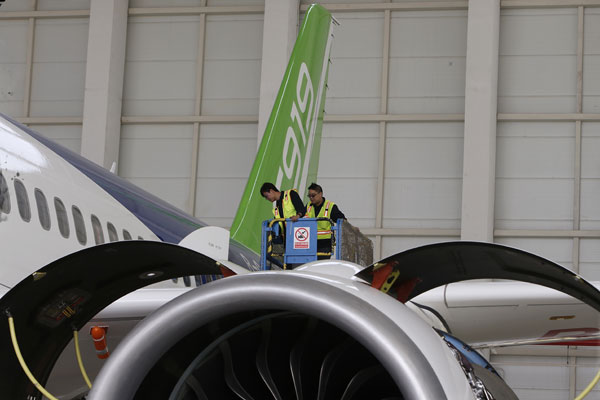Aviation industry to fly on wings of C919
 |
|
Two technicians inspect an engine on the C919, China's first domestically produced single-aisle passenger jet, after a taxiing test on Wednesday.[Photo by Yin Liqin/China Daily] |
Editor's note: China's passenger jet C919 is due to make its debut flight at Shanghai Pudong International Airport on Friday. Gao Zhenghong, a professor at the School of Aeronautics, Northwestern Polytechnical University, who led the team that designed the airfoil for the C919, explains the importance of the aircraft to China Daily's Zhang Zhouxiang.
Many people have pinned hopes on the C919, because it is the first domestically-built large passenger plane and could be put into operation between 2020 and 2022. Can you name a few advanced technologies it uses?
I will give only one example. An essential quality index of modern passenger jets is the percentage of third-generation aluminum-lithium (Al-Li) alloy, a common material in the aircraft-making industry, and advanced composite materials used in a plane. Al-Li alloy comprises 8.8 percent and advanced composite materials 12 percent of the total materials used in the C919. And on both scores, the C919 is an improvement on the ARJ21, another domestically designed and built commercial aircraft.
More importantly, advanced composites have been used to build some load-carrying structures of the plane, such as the empennage (rear part of the body) and the horizontal stabilizer. That shows the development of domestic aircraft-making technology.
Some Western media outlets claim China "assembled" rather than "manufactured" the C919, as it has used many foreign technologies. Would you like to comment on that?
It's true we have used some foreign technologies in building the C919. For example, the aircraft has double CFM LEAP-1C engines, which are made by CFM International, a US-France joint venture. But that does not change the fact that the C919 was domestically made. Domestic research teams worked out its design, structure, aerodynamic layout and so on. That's why China has "independent intellectual property rights" over the C919.
Is the making of the C919 a milestone in the history of China's manufacturing industry?
I think so. A quite high percentage of its parts were made in China, which in turn required high-level domestic industries. Since the procedure for even assembling all the parts to build an aircraft is very complex, successfully completing it is a milestone in itself.
So what industries will the C919 promote?
There are so many: Metallurgy, material science, electronics and integrated circuits. For example, the C919 needs more reliable airborne equipments, and researchers will work out how to make them. It needs lighter but firmer materials and better structural design, which will help propel the material science and structural design sectors.
And although the engines installed in the C919 are foreign made, we cannot rule out the possibility of it using domestically made engines in the future. That will come as a challenge which, if successfully met, will boost the fortunes of engine-making companies.
Certain media outlets have said that thanks to the C919, the Commercial Aircraft Corporation of China poses a challenge to Boeing and Airbus, the two giants of the aviation industry.
I cannot say that. In my opinion, the building and debut flight of the C919 is more of a startup for the domestic aviation industry, because we have for the first time built such a passenger jet. It should give us the confidence to move forward.
Just like the Chinese saying, a journey of a thousand miles begins with a single step, and the C919 is the first step. We now know how to proceed further and accelerate our pace. With more support from the State and society, the domestic aviation industry will develop smoothly.
So what will be development direction of the domestic aviation industry now?
That's a national strategy, not an individual choice. The building of large passenger jets should be a State-level project, rather than a mission that can be completed by one or two groups. But I'm confident that with more support, China's aviation industry will surely prosper.





















